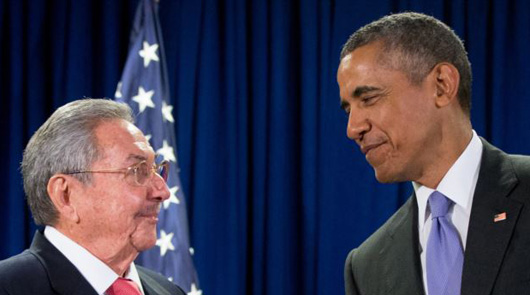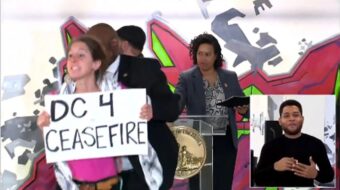
On Sunday March 20, President Obama made history when Air Force One touched down at José Martí International Airport in Havana, Cuba at 4:19 PM local time. He is the first U.S. president since Calvin Coolidge to visit the island nation. When Coolidge arrived for the Pan-American Conference aboard the warship U.S.S. Texas in 1928, he carried with him a message of U.S. support for a corrupt and bloodthirsty dictator, Gerardo Machado.
This time, the U.S. president goes to Cuba for a two-day state visit that caps a remarkable process of reconciliation that began on December 17, 2014 with a joint declaration by Obama and Cuban President Raúl Castro.
This trip by Obama cements the commitment that was made on that day to normalize relations between Cuba and the United States – relations which have been in the deep freeze since the triumph of the Cuban Revolution in 1959.
Since that revolution, and through all the Cold War years that followed, successive U.S. administrations have done their best to bring down Cuba’s socialist government. An iron economic blockade, industrial and agricultural sabotage, terrorism costing thousands of Cuban lives, and more than 600 attempts to assassinate Cuban President Fidel Castro – all of these attacks and more have been visited on Cuba over the years.
None of these efforts, however, stopped the Cuban people from building their own innovative form of socialism. They did not stop Cuba from building the best health care and educational systems in Latin America. Nor did they stop the country from providing help to the peoples of many different countries in Latin America, Africa, and Asia who were trying to free themselves from poverty and exploitation. Cuba’s role in helping to end the apartheid regime in South Africa, for instance, marks one of the island nation’s finest moments.
The disappearance of the Soviet Union and the Eastern European socialist states in 1989-91 created a severe crisis for the country. However, the people of Cuba were not daunted. They sought ways to adapt and survive under the harsh conditions that followed the loss of their major trading partners.
The long road to today’s breakthrough
Since that time, a number of developments have coalesced to produce the current thaw between Washington and Havana.
International opposition to the anti-Cuba policy of the United States has grown. From 1991 onward – every year for 24 years – the United Nations General Assembly has voted to denounce the blockade by increasingly lopsided margins. In the fall of 2015, the gap grew to 191 votes to 2. Every single member country, with the exception of Israel and the United States, voted to end the blockade, including all of the U.S.’ other allies and major trading partners.
Here at home in the U.S., not only progressive activists but also major business blocs have begun to actively lobby against the blockade in recent years once they realized the profit-making opportunities they were losing to competitors from other countries. The power of the right-wing Cuban exile lobby in South Florida has also waned as younger Cuban-Americans drift away from the intransigent positions of the older generation and as the ethnic demographics of Florida have changed.
And of course, the pivotal role of President Barack Obama cannot go unmentioned. His willingness to buck more than a half century of hostility and to stand up to Republican belligerence on the Cuba issue will be remembered as highlights of his presidential legacy.
All of these developments – along with the intervention of Pope Francis and a number of other foreign leaders – led eventually to the breakthrough announcements of December 2014. Subsequently, tough but respectful negotiations between the United States and Cuba led to a series of constructive steps. The Obama administration issued executive orders making it easier for U.S. citizens to travel to Cuba and do business there. The last of the Cuban Five prisoners were released in a swap for Alan Gross. Cuba was removed from the U.S. list of state sponsors of terrorism. And finally, full diplomatic relations were restored between the two countries.
Negotiations continue on a number of fronts, and there is a lot more to be done. The Cuban side, while expressing satisfaction with the progress so far, has pointed out some of them. Among the next priorities, the blockade must be definitively ended so that Cuba can sell its products in the United States as well as buy U.S.-made goods and the U.S. occupation of the Guantánamo Bay Naval Base has to be ended.
The tasks ahead here at home
Whether the potential benefits opened up by this breakthrough can be realized depends entirely on the outcome of the elections on November 8.
Should any of the Republican candidates win the presidency, there is a high likelihood that the rapprochement between the United States and Cuba would be stopped or reversed.
Although Donald Trump says that he is “fine with” the Obama Cuba policy, he adds that he would have pushed for more concessions from Cuba. Given Trump’s well-known delicate touch in dealing with foreign countries, it is likely that he would end up scuttling the whole initiative.
Ted Cruz has declared that he would reverse the policy of reconciliation with Cuba and break off recently re-established diplomatic relations. He cozies up to the most reactionary elements of the Cuban exile community in South Florida on this and other issues.
John Kasich uses softer language, but he also basically opposes a full normalization of relations between the United States and Cuba.
On the Democratic side, meanwhile, both Bernie Sanders and Hillary Clinton approve of Obama’s normalization moves and say they will continue them.
To completely eliminate the U.S. blockade of Cuban trade, though, it will be necessary to pass legislation in both houses of Congress. The current balance of power makes any legislative advance on the issue difficult, to say the least.
Therefore, it is also essential that the GOP be defeated in the Senate and House elections wherever possible. While we rightly pay attention to the very dramatic presidential election, we must also be ready to pitch in at the Congressional level, and create a Congress that will cooperate with the rapprochement that Presidents Obama and Castro have initiated.
This is the greatest chance we have ever had to do right by the Cuban people. Let’s get to work.
Photo: AP












Comments